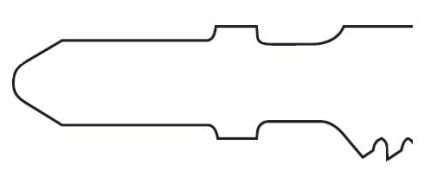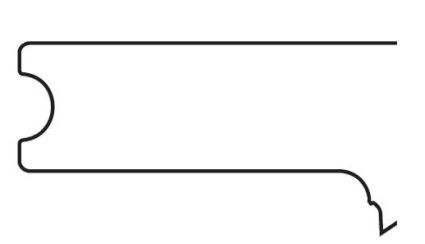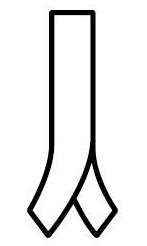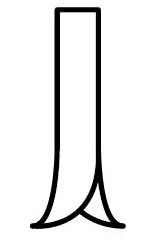Why Read This Article?
Finish Nailer Repair - Replacing the Driver Guide (Ridgid Part # 79004001022)
Article Breakdown
Finish Nailer Repair - Replacing the Driver Guide (Ridgid Part # 79004001022)
Manufacturers usually advertise jigsaw blades by their intended application material (wood, metal, ceramic, tile, etc.). There's nothing wrong with choosing a blade by its labeled application, but it helps to know some details about jigsaw blade specifications if you have any doubts.
![]() From cutting teeth sets to shank styles, this article covers the basics for shoppers to get the jigsaw blade that matches their needs every time.
Jigsaw Blade Shanks
From cutting teeth sets to shank styles, this article covers the basics for shoppers to get the jigsaw blade that matches their needs every time.
Jigsaw Blade Shanks
Jigsaw blades can have different shank styles that are not cross-compatible with other systems. The most accurate way to make sure that you get a jigsaw blade that matches your jigsaw is to check your jigsaw's manual.
Some jigsaws are designed to accept two or more shank styles, while others can only accept one style.
Traditionally, there are three types of jigsaw shank styles, but some are much more widely used than others.
T-Shanks-

The t-shank style is currently the most popular and widely used of the three, and many jigsaws that accept u-shank blades also accept t-shanks blades.
T-shanks were designed for faster blade changing systems, and newer jigsaws require little more than a push of a button to change a t-shank blade.
U-Shanks-

U-shanks are sometimes called "universal" shanks, but they are an older shank style that is not as widely used as it used to be. This decline in popularity partially owes to the development of the t-shank style and its faster changing speed.
Most u-shank jigsaw blades require being fastened into place with some kind of Allen key and retaining screw, slowing down the blade changing process.
Bayonette-
This shank style was previously used by older Porter Cable jigsaw models, but it has since been discontinued.
[Back to top]
Jigsaw Blade Sets and Cutting Teeth
Milled tooth and ground tooth designs can be combined with the the major set types below. For example, side set style jigsaw blades can be found in both milled and ground teeth varieties.
Tooth type (milled or ground), set style, and a few cutting teeth specifications work together to engineer jigsaw blades to specialized jobs.
Milled Tooth Sets
"Milled" Tooth Design:
 "Milled" type saw teeth are more blunt than ground teeth. Although this makes for a rougher, faster, more aggressive cut, it also makes milled tooth jigsaw blades more wear resistant when cutting denser materials.
"Milled" type saw teeth are more blunt than ground teeth. Although this makes for a rougher, faster, more aggressive cut, it also makes milled tooth jigsaw blades more wear resistant when cutting denser materials.
Milled Side Set-

This combination is for straight, fast, rough cutting through woods, aluminum, non-ferrous metals, and plastics.
Milled Wavy Set-

The milled wavy set combination makes jigsaw blades usable for straight, fine cuts in particle board, plywood, aluminum, plastics, and mild steel.
[Back to top]
Ground Tooth Sets
Ground" Tooth Design:
 "Ground" saw teeth are filed further to a sharper edge and point. This makes ground tooth blades better for finer cutting, although they will cut slower.
"Ground" saw teeth are filed further to a sharper edge and point. This makes ground tooth blades better for finer cutting, although they will cut slower.
Also, the additional exposure of the of the blade teeth from the extra sharpening makes ground tooth blades wear more quickly. Because of this, ground tooth jigsaw blades usually are not best for cutting high density materials.
Ground Side Set-

This combination of ground cutting teeth and a side set style allows both straight and curved cutting in wood material and some plastics. These blades will cut quickly when the material is not too dense, and will tend to cut more coarsely than taper ground blades.
Ground Taper Set-

Ground jigsaw blade teeth combined with a straight "taper" set adapt these blades for precise, fine cutting in wood, plywood, and plastic. Both straight and curved cuts are possible.
Ground Reverse Set-

As can be seen from the diagram, reverse ground jigsaw blades are like taper ground blades (straight, sharp teeth), but the teeth point in the opposite direction.
This type of blade is for use with plywood, melamine, and other brittle materials that have a tendency to chip. Reversing the direction of the teeth ensures that the top (surface) portion of the cut is the finest and most precise.
[Back to top]
TPI and Additional Blade Types
TPI-
Teeth Per Inch (TPI) is a major performance-determining factor for jigsaw blades. Like with other types of cutting accessories, TPI affects the speed of a cut, the roughness of a cut, and the application materials for which a blade will be suited.
Lower TPI means faster, rougher cutting, and is better for softer materials. Blades for metals and other dense materials will have higher TPI, cut more slowly, and cut more finely.
In general, blades that have between about 6 and 20 teeth per inch are best for wood and other soft materials. Blades between about 14 and 36 teeth per inch are better suited for metal sawing and other harder materials. Blades with more than 36 teeth per inch are usually for specialty applications like tile or glass.
Additional Blade Types-
Progressor and variable pitch blade styles are also available for jigsaw blades, although they are not as common as with bandsaw blades and reciprocating saw blades.
Both of these blade types strike a balance between cutting speed and precision that gives them an all-around performance quality.
[Back to top]
Jigsaw Blade Materials
Choosing between jigsaw blade materials is similar to other cutting accessories, and some decisions will be made by the material being cut.
Extremely hard materials, like class, ceramic, and steel will require the hardest blade materials like tungsten carbide. However, shoppers can choose between several blade materials when they're planning to saw wood.
The four jigsaw blade materials listed below become harder and more expensive going down the list.
High Carbon Steel-
Although they wear the fastest, carbon steel blades are flexible and inexpensive. They are especially good when cheap, dependable woodworking blades are needed for general shop use.
High Speed Steel-
High speed steel blades are harder and more wear resistant than carbon steel blades, but they can be easily damaged from heat. They are also a little less flexible than carbon steel blades, and a little more expensive.
Bi-Metal-
Bi-metal blades combine the best of carbon steel and high speed steel blades.
The bodies of bi-metal blades are made from carbon steel for flexibility, and then high speed steel teeth are bonded to the body for extra durability.
Tungsten Carbide-
The most expensive jigsaw blade material, but also the most needed for specialty applications.
[Back to top]
Conclusion
We have the jigsaw blades you need here at eReplacementParts.com. Visit our Jigsaw Blades page to view our inventory of jigsaw blades from several manufacturers.
Customers can search our inventory by narrowing result to only include the blade designs they're looking for. Take this opportunity to put our information tools to the test, and take advantage of our fast, professional shipping service.
[Back to top]
What we're about.


















































